Using Maize (Corn) as an Adjunct in Beer Brewing
Published: July 22, 2025 at 7:06:23 AM UTC
Beer brewing has a rich history, with various ingredients used to create unique flavors and styles. Corn (maize) is one such ingredient, commonly used in mass-market beers in North America. Corn can make up to 20% of the grist, resulting in a lighter color and flavor in beer compared to barley malt. By understanding corn's role in brewing, brewers can craft distinctive and flavorful beers. These beers highlight the versatility of this ingredient.
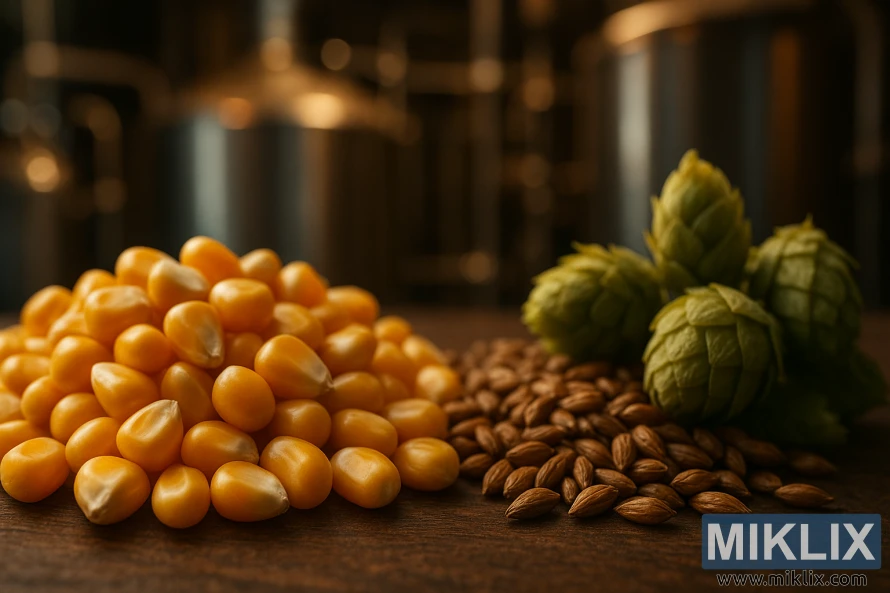
Key Takeaways
- Corn is a common adjunct in North American beer brewing.
- It is typically used as up to 20% of the grist.
- Corn produces a lighter color and flavor in beer.
- Brewers can create unique beers by understanding the role of corn.
- Corn has been used in beer brewing for centuries.
Understanding Corn's Role in Beer Brewing
Corn was a key ingredient in early European settlers' brewing in the New World. They used it for fermentables, thanks to its availability and ability to ferment. This helped them produce beer.
Its use wasn't just for fermentables. Corn also lightened the flavor of husky American 6-row barley. This was a technique German brewers brought to the United States.
The history of corn in brewing shows its versatility and importance. Key aspects of corn's role include:
- Providing a source of fermentables
- Lightening the flavor of robust barley varieties
- Influencing the overall character of the beer
Grasping these points is essential for understanding corn's role in brewing. It highlights its impact on the final beer.
Types of Corn Products for Brewing
Corn is a versatile ingredient in beer brewing, available in multiple forms. Brewers can choose from a variety of corn products, each with its own characteristics and brewing applications.
The primary forms of corn used in brewing are flaked maize, corn grits, and corn sugar. Flaked maize is a pre-gelatinized form of corn that can be added directly to the mash, simplifying the brewing process. Corn grits, on the other hand, require cooking before they can be added to the mash to convert their starches into fermentable sugars.
Corn sugar, also known as brewing sugar or dextrose, is used to increase the alcohol content of beer without affecting its body, color, or flavor. It's typically added to the brew kettle during the boiling process.
The choice of corn product depends on the brewer's goals, including the type of beer being brewed and the desired characteristics of the final product. Here are some common uses for each type:
- Flaked maize: Adds a subtle corn flavor and can help to create a smoother, more rounded beer.
- Corn grits: Provides a starchy source that, when converted, can increase the fermentable sugar content.
- Corn sugar: Increases alcohol content and can aid in achieving a drier finish.
Understanding the different types of corn products and their applications is key for brewers looking to experiment with corn as an adjunct in their recipes.
Chemical Composition of Corn in Brewing
The chemical makeup of corn is vital in beer brewing. Corn is mainly starch, a key element in brewing. It can be turned into fermentable sugars.
Corn's starch content is about 70-80% of its dry weight. This starch includes amylose and amylopectin, complex carbs that break down into simpler sugars during mashing. This high starch level makes corn appealing for brewers, boosting the beer's alcohol and body.
Corn also has protein, but less than grains like wheat. Its protein is around 8-10%. Crucially, this protein is not gluten, making corn safe for those with celiac disease or gluten intolerance.
Corn's fiber content is also noteworthy. While it doesn't contribute to fermentable sugars, it influences the beer's texture and mouthfeel.
For brewers, understanding corn's chemical makeup is key. Knowing its starch, protein, and fiber levels helps manage the brewing process. This ensures consistent and high-quality beers.
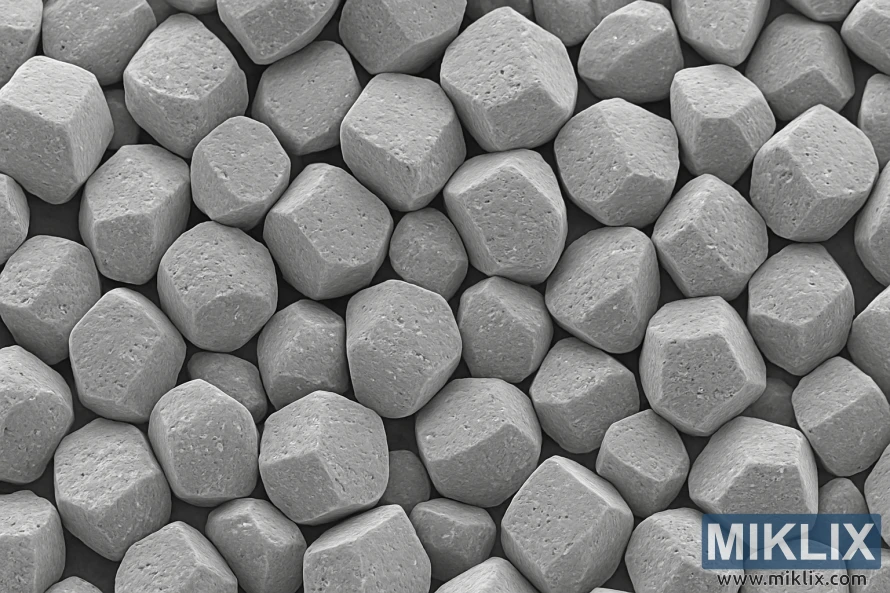
Preparing Corn for the Brewing Process
To effectively use corn in beer brewing, it must undergo a critical preparation. This includes cooking and gelatinization. Corn's gelatinization temperature is higher than barley's, requiring cooking before adding it to the mash.
Gelatinization breaks down corn's starches, making them ready for conversion into fermentable sugars. Cooking corn heats it to a point where its starch granules are disrupted. This facilitates the conversion process.
The process of preparing corn for brewing involves several essential steps. First, the corn must be cooked to achieve gelatinization. This can be done through boiling or steaming. It ensures the starches are fully broken down.
- Cooking corn to achieve gelatinization
- Ensuring the starches are fully broken down for conversion
- Integrating the cooked corn into the mash for brewing
Properly preparing corn through cooking and gelatinization optimizes its use in brewing. This leads to a more efficient brewing process and a higher quality final product.
The Science Behind Corn Adjuncts
The conversion of corn starches into fermentable sugars is key in brewing with corn adjuncts. Corn serves as both a starch source and a sugar source. This enzymatic process transforms its starch into fermentable sugars.
Enzymes break down corn starches into simpler sugars during brewing. This step is vital because yeast can then ferment these sugars. This fermentation produces alcohol and carbon dioxide, creating beer. The efficiency of this conversion greatly affects the beer's character and quality.
The science of corn adjuncts goes beyond starch conversion to sugar. It also involves the fermentation of these sugars. The type of corn, brewing methods, and enzymes used all impact the fermentation. These factors shape the beer's flavor.
Grasping the science behind corn adjuncts helps brewers refine their recipes. This ensures consistent quality and distinct flavors in their beers.
Incorporating Corn into Your Mash
Adding corn to your mash is a precise art that can significantly enhance your beer's quality and depth. Brewers have two main choices: flaked maize and corn grits. Each offers unique benefits for your brew.
Flaked maize can be mixed directly into the mash, providing a straightforward source of fermentable sugars. In contrast, corn grits need to be cooked first. This step is essential to gelatinize the starches properly.
- Flaked maize is simpler to use, as it doesn't need cooking.
- Corn grits, when cooked right, can add a richer flavor to your beer.
- The choice between flaked maize and corn grits depends on the brewer's specific needs and preferences.
Understanding the differences between these corn products and how to use them in your mash is key. It helps brewers refine their recipes and achieve the beer they envision.
By carefully choosing and preparing the corn adjunct, brewers can ensure a smooth brewing process. This leads to a high-quality final product.
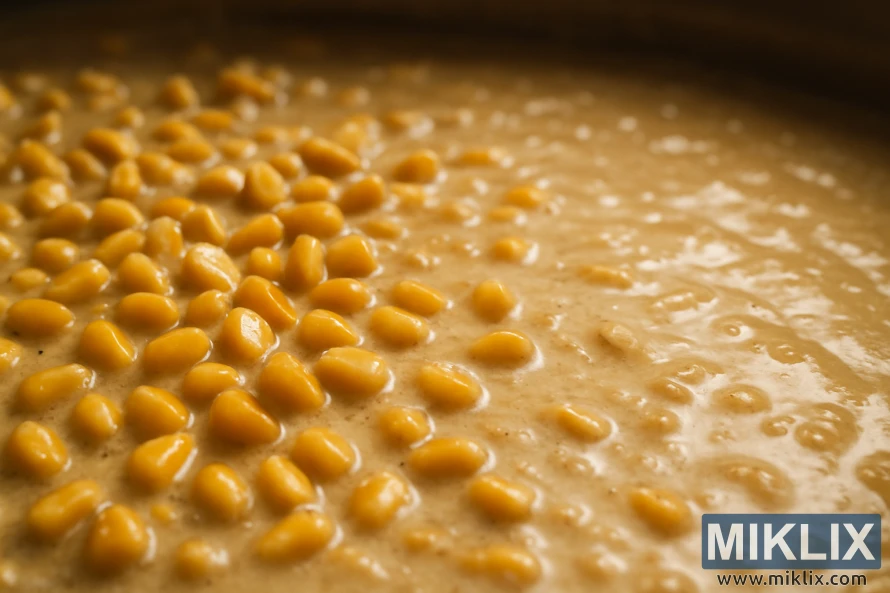
Effect on Beer Characteristics
Using corn as an adjunct in brewing changes the beer's color, flavor, and body. Corn makes the beer lighter in color and taste compared to barley malt. This makes it a favorite for brewers wanting to craft lighter, more refreshing beers.
Corn's impact on beer characteristics falls into three main areas:
- Color: Corn leads to a lighter color, which is perfect for certain beer styles.
- Flavor: The taste is cleaner and less malty, appealing to those who like a milder flavor.
- Body: Corn can make the beer lighter, improving its drinkability.
Knowing how corn influences these aspects helps brewers fine-tune its use in their recipes. This way, they can create beers that fit specific style guidelines or meet consumer preferences.
By adjusting the amount of corn in brewing, brewers can achieve the perfect balance of color, flavor, and body. This makes corn a versatile adjunct in beer production.
Common Brewing Challenges with Corn
Using corn as an adjunct in brewing comes with significant hurdles. The gelatinization process is a major challenge. Corn's starches need to be gelatinized and then converted into fermentable sugars. This is essential for effective use in brewing.
Gelatinization involves starches absorbing water and swelling, breaking down their crystalline structure. Corn requires a higher temperature than barley for gelatinization. This often means a cooking step before adding it to the mash.
Converting starches into fermentable sugars is another critical challenge. Enzymes must break down these starches into sugars that yeast can ferment. Ensuring adequate enzyme activity is key for successful conversion.
Brewers often face issues like inadequate gelatinization, insufficient conversion, and off-flavors. These problems arise if the corn is not properly processed.
- Ensuring corn is cooked to the correct temperature for gelatinization.
- Maintaining adequate enzyme levels for starch conversion.
- Monitoring the brewing process to prevent off-flavors.
By understanding and addressing these challenges, brewers can optimize their use of corn in beer recipes. This leads to consistent and high-quality results.
Calculating Proper Corn Ratios
The right corn ratio is key to optimizing your mash composition and beer quality. Finding the correct amount of corn for your grain bill greatly affects brewing.
When setting the ideal corn ratio, brewers must think about the beer type and desired final product. For example, in North American mass-market beers, corn can make up to 20% of the grist.
- Determine the total grain bill for the brew.
- Decide on the percentage of corn to use based on the beer style and desired characteristics.
- Calculate the amount of corn needed in pounds or kilograms.
- Adjust the amount of other grains in the grain bill to fit the corn.
For instance, if a brewer aims to make a beer with a 100-pound grain bill and wants 15% corn, they need 15 pounds of corn. The remaining 85 pounds will go to other grains in the recipe.
Some common guidelines for corn ratios include:
- Use corn as 10-20% of the grain bill for lighter, crisper beers.
- Include corn as 5-15% of the grain bill for beers with a slightly sweeter flavor.
- Adjust the corn ratio based on the type of corn product used (e.g., flaked corn, corn grits).
By carefully calculating the proper corn ratio, brewers can optimize their grain bill and mash composition. This leads to high-quality beers with the desired characteristics.
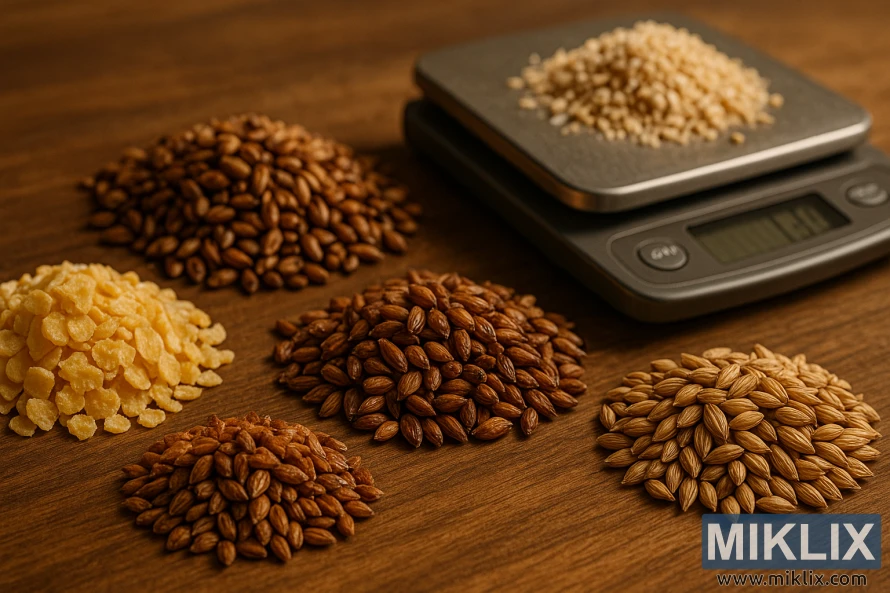
Best Beer Styles for Corn Adjuncts
Brewing with corn adjuncts opens a world of possibilities for craft brewers, applicable to lager, ale, and beyond. Corn can enhance various beer styles in unique ways, adding to their characteristics.
Corn adjuncts are well-suited for specific beer styles. Here are some of the best beer styles that benefit from corn:
- Lagers: Corn is traditionally used in brewing American-style lagers, contributing to a cleaner, crisper flavor profile.
- Ales: Certain ale styles, focusing on fermentable sugars, can benefit from corn's addition. It enhances the beer's body and flavor.
- Specialty Beers: Brewers experimenting with unique flavors and ingredients often use corn. It adds versatility and subtle sweetness.
The use of corn in these styles adheres to traditional brewing practices while allowing for innovation. For instance, in lager brewing, corn helps achieve a lighter color and flavor. This is characteristic of many popular lager styles. In ales and specialty beers, corn can contribute to a more complex flavor profile, depending on its use.
When deciding on the best beer style for corn adjuncts, brewers should consider the desired flavor outcome and the type of corn product. Whether it's corn grits, corn flakes, or another form, each will impart different characteristics to the beer.
In summary, corn adjuncts can elevate a variety of beer styles, from classic American lagers to experimental ales and specialty beers. Understanding how to best utilize corn in your brewing process can lead to the creation of unique, high-quality beers that stand out in the market.
Quality Control Measures
Implementing robust quality control measures is essential for brewers using corn in their recipes. Ensuring the quality of the final product involves monitoring several critical factors. This starts with the quality of the corn itself.
Corn quality can significantly affect the beer's overall quality. It's vital to source high-quality corn. This means checking for moisture content, contamination, and freshness.
In addition to corn quality, brewing parameters such as temperature, pH, and enzymatic activity must be carefully controlled. These parameters play a vital role in the mashing process. They affect how well the corn adjuncts contribute to the beer's fermentable sugars.
- Regularly inspect corn for visible signs of deterioration.
- Maintain optimal brewing temperatures to ensure enzymatic activity.
- Monitor pH levels to prevent unwanted flavor compounds.
By focusing on these quality control measures, brewers can optimize their use of corn adjuncts. This leads to consistent, high-quality beers that meet consumer expectations.
Commercial vs. Homebrewing Applications
The scale and equipment used in commercial brewing versus homebrewing significantly affect how corn adjuncts are utilized in the brewing process.
Commercial breweries often employ large-scale equipment and specialized techniques to brew beer with corn adjuncts. This can include industrial-sized mash tuns, lautering equipment, and fermentation tanks that allow for precise control over brewing conditions.
In contrast, homebrewers typically use smaller-scale equipment and simpler techniques. Homebrewing setups can range from basic to sophisticated, but they generally allow for more flexibility and experimentation with different brewing methods and ingredient ratios.
Some key differences between commercial and homebrewing applications include:
- The scale of production, with commercial breweries producing much larger batches.
- The complexity and specificity of equipment, with commercial breweries using more advanced and specialized machinery.
- The level of control over brewing parameters, such as temperature, pH, and mash consistency.
Understanding these differences can help both commercial breweries and homebrewers optimize their use of corn adjuncts in their recipes and achieve the desired beer characteristics.
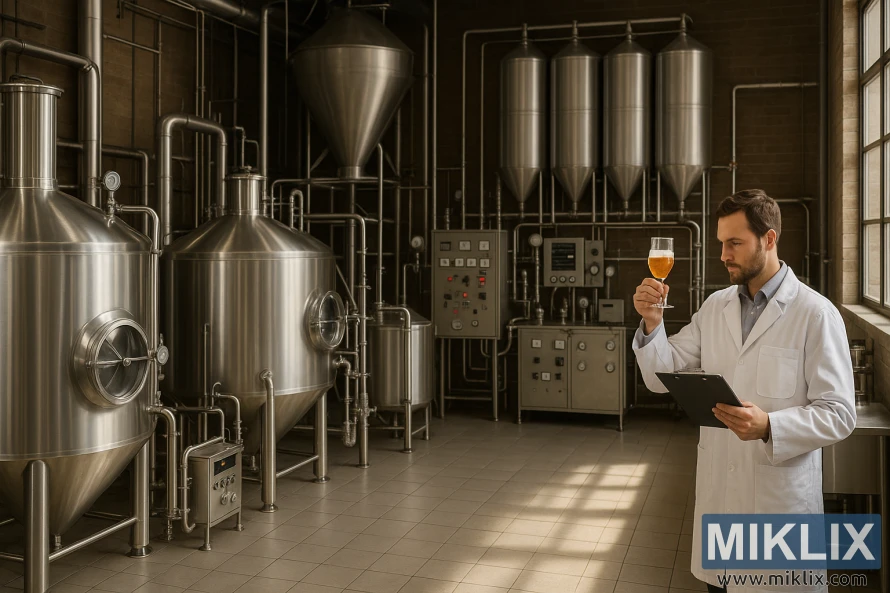
Troubleshooting Common Issues
Corn adjuncts can introduce unique challenges to the brewing process, including issues with gelatinization and fermentation. Understanding these challenges is key for brewers to optimize their recipes and produce high-quality beer.
One of the primary issues brewers face when using corn adjuncts is achieving proper gelatinization. Gelatinization is the process by which starches are converted into a more accessible form for enzymes. Incomplete gelatinization can lead to reduced extract yields and affect the overall character of the beer.
- Ensure that the corn is properly milled to facilitate gelatinization.
- Monitor the temperature and pH during the mashing process to optimize conditions for gelatinization.
- Use enzymes designed to enhance starch conversion.
Conversion problems are another common issue. This occurs when the starches in the corn are not fully converted into fermentable sugars. This can result in a beer that is too sweet or has an unbalanced flavor profile.
To address conversion issues, brewers should:
- Verify that the mashing temperature is within the optimal range for the enzymes being used.
- Ensure adequate mixing during the mashing process to facilitate even conversion.
- Monitor the iodine test to confirm complete conversion of starches.
Fermentation problems can also arise when using corn adjuncts. These can include sluggish or stuck fermentations, which may be due to inadequate nutrient supply or improper yeast pitching rates.
To troubleshoot fermentation issues, consider the following:
- Ensure that the wort is adequately oxygenated before pitching the yeast.
- Monitor yeast health and pitching rates to ensure they are within optimal ranges.
- Supplement the wort with necessary nutrients to support healthy fermentation.
By understanding and addressing these common issues, brewers can effectively troubleshoot problems related to corn adjuncts. This will improve the quality and consistency of their beers.
Environmental and Cost Considerations
The brewing industry faces growing pressure to lessen its environmental impact. The choice of ingredients is critical in this effort. Sustainability and cost-effectiveness are essential for breweries considering corn adjuncts.
Corn is cheaper than other grains, appealing to breweries aiming to cut costs without sacrificing quality. It's also a common crop, easily sourced locally in many areas. This reduces transportation costs and environmental effects.
Using corn adjuncts supports sustainable brewing in several ways. Corn needs less water than some grains, aiding in a more efficient brewing process. The savings from corn can also fund other sustainability projects within the brewery.
- Reduced ingredient costs
- Lower transportation emissions through local sourcing
- Potential for more efficient brewing processes
By grasping the environmental and cost aspects of corn adjuncts, breweries can make better choices. This leads to more sustainable and cost-effective operations.
Conclusion
Mastering corn in beer brewing demands a thorough grasp of its traits, uses, and boundaries. Understanding the science behind corn adjuncts allows brewers to refine their recipes. This leads to the creation of unique, flavorful beers.
This article has covered the key aspects of using corn in brewing, from preparation to addressing common problems. As brewers explore new uses for corn, they can anticipate exciting developments in beer production.
In summary, corn is a versatile ingredient that can elevate beer quality and character. By applying the insights from this article, brewers can confidently use corn in their brewing. This opens the door to innovative beer styles and flavors.
Further Reading
If you enjoyed this post, you may also like these suggestions:
- Using Rye as an Adjunct in Beer Brewing
- Using Roasted Barley in Beer Brewing
- Using Rice as an Adjunct in Beer Brewing
